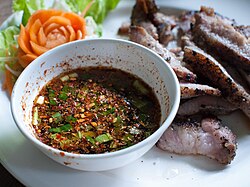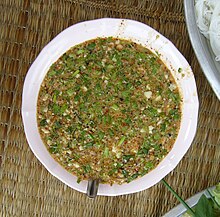Nam chim
 Nam chim chaeo | |
| Type | Dip |
|---|---|
| Place of origin | Thailand |

Nam chim or Nam jim (Thai: น้ำจิ้ม, IPA: [nám tɕîm]) is Thai for "dipping sauce". It can refer to a wide variety of dipping sauces in Thai cuisine, with many of them being a combination of salty, sweet, spicy and sour.[1] Nam chim tend to be more watery in consistency than nam phrik (Thai chilli pastes). Although Sriracha sauce is commonly known as sot Sriracha in Thailand (sot is the Thai pronunciation of the English word "sauce"), it will sometimes also be called nam chim Siracha or nam phrik Siracha.
A more or less generic and basic nam chim is the one used for grilled or steamed seafood. This sauce will contain garlic, fish sauce, sugar, lime juice, and bird's eye chilies. Variations on this basic recipe find their use as a dipping sauce with, but also as an integral part of a multitude of dishes. Many of the ingredients in a nam chim are finely chopped or pounded in a mortar and pestle or, non-traditionally, ground in a blender.
Popular dipping sauces in Thailand are:
- nam chim kai (Thai: น้ำจิ้มไก่), A very common all-round chilli dipping sauce with the consistency of a thick syrup, it is medium spicy and very sweet, normally referred to as "sweet Thai chili sauce" in English. Often used as a dipping sauce for grilled chicken (kai means "chicken"), it can also be used as a generic chilli sauce for other dishes. It forms the base of a few other types of nam chim, such as nam chim thot man pla ("dipping sauce for deep-fried fish cakes").
- nam chim chaeo (Thai: น้ำจิ้มแจ่ว), using ground dry-roasted glutinous rice, this sauce is most often eaten with mu yang/mu ping (grilled pork) or kai yang (grilled chicken)[2]
- nam chim sate (Thai: น้ำจิ้มสะเต๊ะ), the Thai version of peanut sauce, it is eaten with Thai satay
- nam chim taengkwa or achat (Thai: อาจาด), the Thai version of the Malay/Indonesian acar timun (cucumber pickles). The Thai variety consists of fresh chopped cucumber, spring onion and chilli, mixed with vinegar and is usually served together with nam chim sate as a dip for satay
- nam chim suki (Thai: น้ำจิ้มสุกี้), eaten with Thai suki (the Thai version of the Chinese hot pot), amongst others, it contains sesame oil and oyster sauce[3]
- nam chim taochiao (Thai: น้ำจิ้มเต้าเจี้ยว), containing yellow soybean paste (taochiao), it is eaten with khao man kai
- nam chim thale (Thai: น้ำจิ้มทะเล), a basic dipping sauce made with garlic, fish sauce, lime juice, sugar and chillies, it is usually eaten with grilled or steamed seafood[4]
- nam chim thot man (Thai: น้ำจิ้มทอดมัน), served as a dip with thot man pla (fried fish cakes), it is similar to nam chim kai but with chopped cucumber, crushed peanut and coriander (cilantro) leaves. For thot man kung or pu (fried prawn or crab cakes) however, a very sweet plum sauce is provided
- nam chim paesa (Thai: น้ำจิ้มแป๊ะซะ), served as a sauce for steamed fish wrapped in steamed cabbage leaves
See also
References
- ^ http://www.gourmetfoodsource.net/thai-saladdressing.htm
- ^ http://www.shesimmers.com/2009/06/how-to-make-jaew-thai-dried-chilli.html
- ^ http://www.austinbushphotography.com/blog/suki-haeng-saphan-leuang%E0%B8%AA%E0%B8%B8%E0%B8%81%E0%B8%B5%E0%B9%89%E0%B9%81%E0%B8%AB%E0%B9%89%E0%B8%87%E0%B8%AA%E0%B8%B0%E0%B8%9E%E0%B8%B2%E0%B8%99%E0%B9%80%E0%B8%AB%E0%B8%A5%E0%B8%B7%E0%B8%AD.html
- ^ http://www.panix.com/~clay/cookbook/bin/show_recipe.cgi?thai+recipe410

